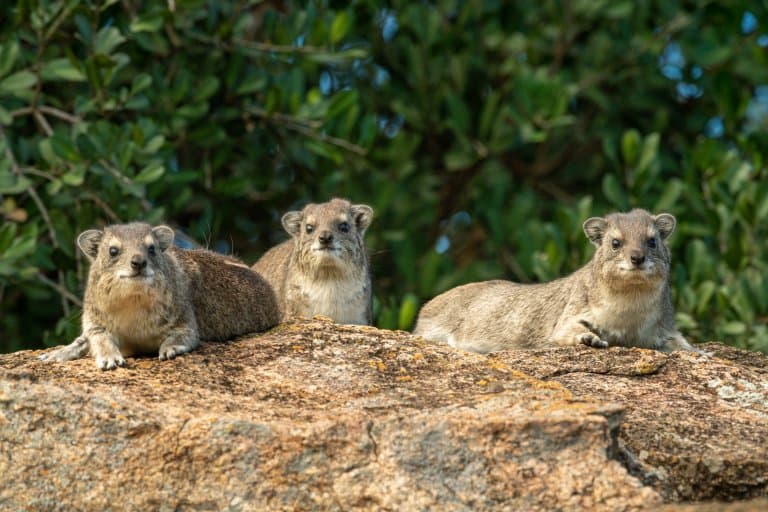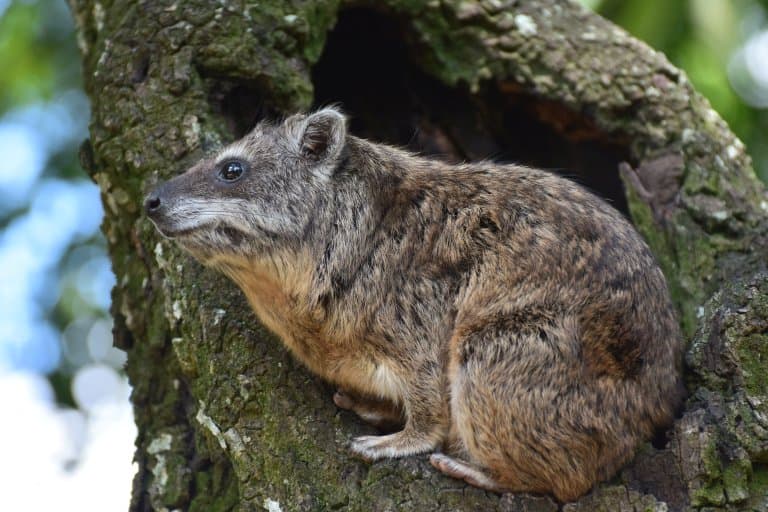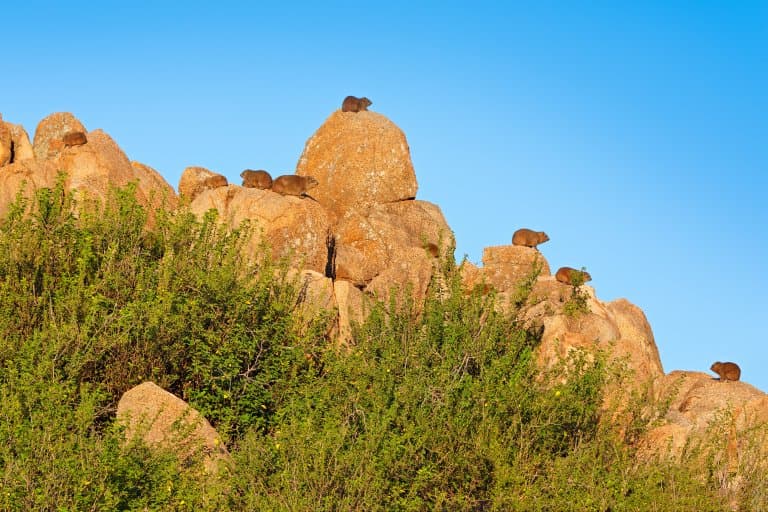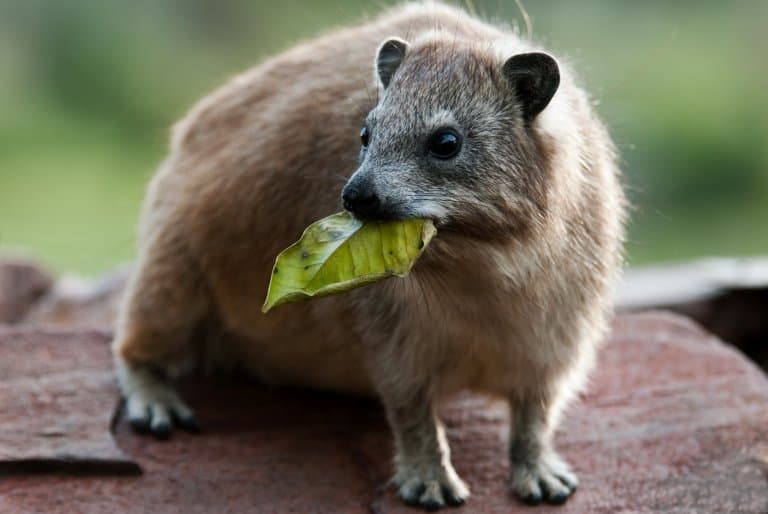Hyrax Profile
Around 50 million years ago, a clade of mammals called Tethytheria, containing some epic, ancient, multi-horned megabeasts, almost went extinct.
Only three branches survived to modern times: the largest land animals in the world, the elephantine Proboscideans; the enigmatic and aquatic sea-cow Sirenians, and some lesser-known dumpy little rodent-like things called Hyraxes also sometimes known as ‘dassies’.
They are small, herbivorous, furry animals that live in Africa and the Middle East.

Hyrax Facts Overview
| Habitat: | Rocks, trees, in forests and savanna |
| Location: | East, North Africa, Middle East |
| Lifespan: | 9 to 14 years |
| Size: | 30-70cm (12-28”) |
| Weight: | 2-5kg (4.4 – 11lb) |
| Color: | Grey or brown |
| Diet: | Leaves, fruits and grasses |
| Predators: | Lions, hyenas, leopards, some snakes, the black eagle |
| Top Speed: | 30 kph (18 mph) |
| No. of Species: |
5 |
| Conservation Status: |
Least concern |
The order Hyracoidea is comprised of five confirmed species (and more possible species to be found) of rabbit-sized, African mammal, many of which spend most of their time trying to stay warm on rocks, or screaming like deranged spirits from the tops of trees.
The 5 species include the rock hyrax (Procavia capensis), the yellow-spotted rock hyrax (Heterohyrax brucei), the western tree hyrax (Dendrohyrax dorsalis), southern tree hyrax (D. arboreus), and eastern tree hyrax (D. validus).
These are some very strange animals, not least because their closest relatives look nothing like them, and all they seem to do is scream, bask, mate and eat leaves.
While there are several species, they can be crudely split into two groups: the nocturnal and solitary tree hyraxes and the social and terrestrial rock hyraxes, or “rock rabbits”.
They live in small family groups and inhabit rocky terrain and seek shelter in existing holes and crevices, rather than making their own dens.
Interesting Hyrax Facts
1. Hyraxes are tiny land manatees
Well, not exactly, but they’re the closest thing to a manatee in East Africa, other than an elephant.
The three animals share a common ancestor, and although hyraxes look a lot like rodents on the outside, they have a lot of similarities on the inside, such as their teeth, toes and skull structure, which closer resemble an elephant.

2. They have horrifying vocalisations
If you happen to be sitting peacefully in the Maasai Mara after sunset you might be alarmed to hear a sound that resembles the loud knocking of the old timbers of a ghost ship, especially since ghost ships so rarely migrate so far inland. As puzzling and disturbing as that is, the corresponding banshee screech should be enough to send you cowering.
These are some of the common sounds of the tree hyrax, a nocturnal species of hyrax, and they’re one of countless versions of call that different species and populations of the order make.
Rock hyraxes also scream, laugh and sing, as do other types of tree hyraxes, and it’s thought that there are other, undescribed species out there, identifiable by their unique call.
3. They’re partially cold-blooded
The cold/warm-blooded dichotomy is a bit of an oversimplification. In reality, it’s more of a spectrum, and animals of all kinds sit somewhere along it.
Rock hyraxes are much closer to the cold-blooded side of this spectrum than most mammals, and as a result, tend to bask on sunny rocks to maintain their body temperature and to recover from the hypothermia they sometimes fall into overnight. 1
4. They have built-in sun visors
Sitting on rocks all day is a good way to keep warm, but it comes with a glare that makes you want to put on some sunnies.
Rock hyraxes have a bulge in the iris of the eyeball to act as a permanent sun-block. This helps them keep their vision protected, which in turn allows them a better chance at spotting predators.

5. They get attacked from above
One such predator is the black eagle, for whom hyraxes make up 98% of their diet.
This frightening beast makes up only one of the many predators a hyrax has to deal with on a daily basis. It’s thought that this may be the primary driver for the evolution of the specialized eye in hyraxes. 2.
6. Their Tinder bio is interesting
The bush hyrax has what is known as a “complex” penis. It stands out from those of its relatives in that it has an additional short, thin appendage within a “fleur-de-Lys” penis, which is >6m when erect. That’s pretty impressive for an animal that only reaches 70cm long!
That’s not the end of it. When a male hyrax gets aroused, he experiences an erection on his back. A sexually active dorsal gland sits on the back of the animal, covered in hairs which, when erected expose it for identifying information about the individual to its mate through scent.
7. There are many threatened populations
Tree hyraxes around Mt Kilimanjaro are heavily threatened by hunting and deforestation. These may well be the most endangered of all the hyrax species as a result.
As human populations expand and cut down more forest, the habitats of the tree hyrax provide less space to find mates and to avoid predation. 3
8. They eat some really crappy food
Hyrax diets consist of leafy vegetation and other herbivorous material, but they commonly consume really low-grade, twiggy bits and pieces with little nutritional value.
As an adaptation to this funny habit, they’ve developed a three-chambered stomach with complex bacterial cultures to really get the most out of the nutrient-poor food sources.
In order to inoculate these chambers with the necessary bacteria, young hyraxes eat their parents’ poo. Yum.

9. They have sweaty feet
Rock hyraxes have rubbery feet, laden with sweat glands.
These not only help the animal regulate their body temperature, but they aid in gripping rocks too.
10. Hyraxes have a special claw for grooming
Hyrax toes have rounded, hoof-like nails – except the inside rear toe.
This has a a long nail called a ‘grooming claw’, which is used to scratch and pick through their hair.
11. Conservation attempts continually fail
Efforts to translocate hyrax families and individuals have been fraught with disaster. These animals don’t seem to do well at all after release at their new location. It’s possible that the stress of the relocation causes these families to split up in panic, and the individuals are picked off by any number of the multiple predators they face as a small mammals in Africa.
However, researchers propose that implementing buffer zones of protection around primary habitats can reduce the decline of the threatened species, and stress the importance of clearer taxonomic investigations to identify and categorize the proposed undescribed species. 4
Hyrax Fact-File Summary
Scientific Classification
| Kingdom: | Animalia |
| Phylum: | Chordata |
| Class: | Mammalia |
| Order: | Hyracoidea |
| Family: | Procaviidae |
| Genus: | Dendrohyrax Heterohyrax Procavia |
| Species Names: |
Southern tree hyrax (D. arboreus arboreus) Eastern tree hyrax (D. arboreus validus) Western tree hyrax (D. dorsalis) Yellow-spotted rock hyrax (H. brucei) Rock hyrax (P. capensis) |
Fact Sources & References
- Kelly J. Brown (2007), “Basking behaviour in the rock hyrax ( Procavia capensis ) during winter“, ResearchGate.
- Ngoni Chiweshe (2007), “Black Eagles and hyraxes — the two flagship species in the conservation of wildlife in the Matobo Hills, Zimbabwe“, Journal of African Ornithology
- Hendrik Hoeck, Max-Planck-Institut (2010), “Hyracoidea“, IUCN Afrotheria Specialist Group.
- Paulette Bloomer, Johan Kruger, Mike Maguranyanga (2016), “Heterohyrax brucei – Yellow-spotted Rock Hyrax“, EWT.org.za.
